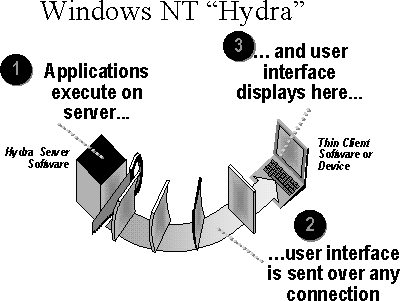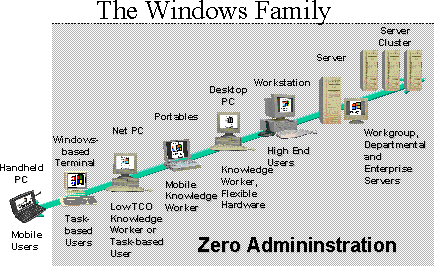
Microsoft Corporation
July 1997
Technology Update: What Is Windows NT Hydra?
Product Overview
Extending the Scalable Windows Family
Summary
For More Information
Glossary of Terms
Microsoft® Windows NT® "Hydra" is the code name for a project that will add Windows®-based terminal support to the Microsoft Windows NT Server operating system and a "super-thin client" to the Windows operating system family product line. This new technology will provide enterprise customers with a compelling new extension to the Windows-based computing environment that combines low total cost of ownership, the familiar 32-bit Windows user interface, and the power and choice of the Windows operating system family. Specifically, Windows NT Hydra will:
Windows NT Hydra is an extension of the Windows NT Server 4.0 product line. In the multiuser environment, a super-thin client allows users to run the Windows desktop operating system and Windows-based applications completely off the server. Windows NT Hydra will provide users access to 16- or 32-bit Windows-based applications from any of the following types of desktops:
Windows NT Hydra consists of three components—the Windows NT Server multiuser core, the T.Share/T.120 remote protocol, and the super-thin Windows–based client software. Specifically:

The ability to deploy a range of cost-effective systems that precisely match user needs is critical to Information Technology (IT) departments. For most companies, "one size fits all" computing does not make business sense. Microsoft is committed to extending the Windows operating system family to meet a broad range of corporate customer needs—from high-end clustered servers handling billions of transactions a day to hand-held roaming devices on factory floors. Windows NT Hydra is the extension of Windows into the super-thin client marketplace. Microsoft will now be able to offer customers a Windows-based solution:
The combination of the Net PC and Windows NT Hydra provide exciting new opportunities for enterprise customers to take advantage of the many benefits of the Windows operating system environment, while still focusing on low cost of ownership.

With Windows NT Hydra, corporations can deploy a super-thin client that does not require the downloading of applications or operating systems from the server. The Windows NT Hydra client contains only the minimum amount of software necessary to boot the device, establish a connection to the server, and present the user interface—all other operating-system functions, as well as the applications, run completely on the server.
Windows NT Hydra offers ways to lower both long-term desktop-management costs, as well as short-term capital-outlay costs. First, since all applications reside only in a single central place—on the server—there is no client software that must be installed or updated on the desktop. This makes application rollouts and updates very simple. Second, because all user-profile information is stored on the Windows NT Hydra Server, client desktops are administered centrally by the server. Third, remote administration capabilities further reduce the cost of handling helpdesk calls. Thus, the Windows NT Hydra environment gains the benefits of all Zero Administration for Windows capabilities available on Windows NT Server. Lastly, with a target price range below $500 per Windows-based terminal desktop, customers will also be able to choose from a wide range of compatible devices from many different hardware vendors. Windows NT Hydra can also be used to extend the life of current low-end Windows-based computer desktops by enabling access to the newest 32-bit applications running off of the Windows NT Hydra server.
In a Windows NT Hydra environment, all applications are run completely from the server. The Windows NT Hydra server provides the host-computing environment, including management of all computing resources on a per-user basis (for example, memory, CPU, and other resources). The multiuser capabilities run on top of Windows NT Server, thus any 16- or 32-bit Windows–based application that will run on a Windows NT-based computer today can be accessed in the Windows NT Hydra environment. In today's server-based multiuser environments, applications compatibility and consistent user-interface presentation can be challenging. Microsoft is committed to a high-quality Windows NT Hydra experience, and will be thoroughly testing popular Windows-based applications such as Microsoft Office, Microsoft Internet Explorer, Microsoft Exchange Server, Microsoft Outlook™, Microsoft Project, and 16- and 32-bit Microsoft Visual Basic®–based applications, as well as other popular 32-bit Windows–based business software products. The underlying goal is to provide the best and most consistent Windows operating system experience for the Windows NT Hydra user.
Because the Windows family of operating systems provides a wide range of solutions, customers are not locked into a Windows NT Hydra environment as their needs change or grow. Virtually any Windows-based desktop (and many non-Windows–based desktops) will work with Windows NT Hydra. If a user requires more power, administrators can easily swap out a Windows-based terminal for a more powerful system, such as a Net PC or personal computer. The user interface, user profile, and applications do not have to be modified, saving end-user training and applications development resources. Also, Windows-based terminals from different manufacturers will be compatible, so they can be mixed and matched.
On May 12, 1997, Microsoft Corporation announced a joint development agreement with Citrix Systems Inc. Under this agreement, Microsoft will license existing Citrix multiuser technology and the companies will cooperate on the development of new Windows NT Hydra technologies for Windows NT Server 4.0 and future versions. Citrix will also market an add-on to the Windows NT Hydra Server, code-named "Picasso," that will support existing and future Independent Computing Architecture–based (ICA-based) Citrix clients. For more information on this and other Citrix products, see the Citrix Systems, Inc. Web site (http://www.citrix.com). Microsoft also announced an agreement with Prologue Software on the same day to license its multiuser technology and for Prologue to cooperate in the development and deployment of Windows NT Hydra.
| Customer need | Windows NT Hydra with Windows-based terminals | Network computer (NC) | Net PC with 32-bit Windows |
| Application processing |
|
|
|
| Manageability |
|
|
|
| Desktop hardware upgrade ability |
|
|
|
| Applications support |
|
|
|
| Applications Development |
|
|
|
With all of the advantages of a managed Windows-based environment, including a familiar user interface, a wide range of applications, choice of hardware for both the server and desktop, centralized administration, and choice of development and administration tools, Windows NT Hydra brings the best of the Windows family of operating systems to customers who need to deliver 32-bit applications to legacy and terminal desktops, or to remote or branch users.
For the latest information on the Net PC and lowering total cost of ownership with Microsoft Windows, see the Microsoft Windows Web site (http://www.microsoft.com/windows/innovation/).
For the latest information on the Windows NT Hydra product, see the Microsoft Windows NT Server 4.0 Web site (http://www.microsoft.com/ntserver/info/hydra.htm).
Microsoft Windows NT Hydra server. Windows NT Hydra is the code name for a software product from Microsoft that will add Windows-based terminal support to Windows NT Server 4.0 and future versions. Windows NT Hydra is not yet a shipping product.
Microsoft Windows NT Hydra client. The Windows NT Hydra client is super-thin client software that will run on new Windows-based terminals, and on existing Windows-based personal computers (Windows 3.11, Windows 95, or Windows NT Workstation). The Windows NT Hydra client presents the 32-bit Windows user interface, and either comes with the hardware device (Windows-based terminal), or is downloaded by the Windows NT Hydra server to the desktop personal computer device.
Windows-based personal computer. A personal computer that runs a 16- or 32-bit Windows operating system (Windows 3.x, Windows 95, or Windows NT Workstation).
Windows-based terminal. A new type of low-cost hardware device optimized specifically to run the Windows NT Hydra client. Windows-based terminals are ideal for a task-based computing environment, and might typically be used to upgrade the classic "green screen" terminals to a Win32 environment. They are similar to the Winterm devices currently in the marketplace. Specifications for this device are currently under development.
The information contained in this document represents the current view of Microsoft Corporation on the issues discussed as of the date of publication. Because Microsoft must respond to changing market conditions, it should not be interpreted to be a commitment on the part of Microsoft, and Microsoft cannot guarantee the accuracy of any information presented after the date of publication.
This document is for informational purposes only. MICROSOFT MAKES NO WARRANTIES, EXPRESS OR IMPLIED, IN THIS DOCUMENT.